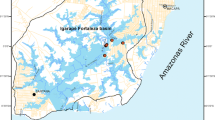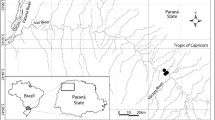Abstract
Parasite community composition of European bitterling (Rhodeus amarus), the only bitterling species occurring on the European continent, was investigated in 16 different localities from four European sea drainages during 1998–2007. A total of 41 species of metazoan parasites was identified. Nine parasite species are new records for European bitterling, namely Dactylogyrus rarissimus, D. suecicus, D. yinwenyingae, Gyrodactylus vimbi, Sphaerostomum globiporum, Petasiger sp., Paryphostomum radiatum, Ichthyocotylurus variegatus and Posthodiplostomum brevicaudatum. The specialist Gyrodactylus rhodei was the most widely distributed and one of the most prevalent species. The most frequent digenean species, represented by larval stages, was Metorchis xanthosomus. The parasite community of European bitterling was characterised by the dominance of generalists and parasites with autogenic life cycles. The rare occurrence of strictly endoparasitic species reflected the specific diet of the fish host. The character of the habitat significantly affected the parasite assemblages of bitterling. The greatest similarity was associated with lentic habitats (gravel pits and oxbows) and the lowest similarity between gravel pits and rivers. Juvenile bitterling from 8mm in length upwards were colonised by metazoan parasites, firstly by the monogenean G. rhodei. Host body size was positively correlated with parasite species richness, but the variability explained by length was low.



Similar content being viewed by others
References
Arai R (1988) Fish systematics and cladistics. In: Ichthyology Currents 1988. Asakura Shoten, Tokyo
Bagge AM, Valtonen ET (1999) Development of monogenean communities on the gills of roach fry (Rutilus rutilus). Parasitology 118:479–487
Barber I, Hoare D, Krause J (2000) Effects of parasites on fish behaviour: a review and evolutionary perspective. Rev Fish Biol Fish 10:131–165
Blažek R, Gelnar M (2006) Temporal and spatial distribution of glochidial larval stages of European unionid mussel (Mollusca: Unionidae) on host fishes. Folia Parasit 53:98–106
Brickle P, MacKenzie K, Pike A (2006) Variation in the parasite fauna of the Patagonian tooth fish (Dissostichus eleginoides Smitt, 1898), with length, season, and depth of habitat around the Falkland Islands. J Parasitol 92:282–291
Bush AO, Lafferty KD, Lotz JM, Shostak AW (1997) Parasitology meets ecology on its own terms: Margolis et al. Revisited. J Parasitol 83:575–583
Dávidová M, Jarkovský J, Matějusová I, Gelnar M (2005a) Seasonal occurrence and metrical variability of Gyrodactylus rhodei Zitnan 1964 (Monogenea, Gyrodactylidae). Parasitol Res 95:398–405
Dávidová M, Ondračková M, Baruš V, Reichard M, Koubková B (2005b) Nematode infections of the European bitterling (Rhodeus sericeus Pallas, 1776: Cypriniformes). Helmithologia 42:45–48
Ergens R, Lom J (1970) Causative agents of parasitic fish diseases. Academia, Prague
Esch GW, Fernández JC (1993) A functional biology of parasitism. Chapman & Hall, London
Fischer SA, Kelso WE (1990) Parasite fauna development in juvenile bluegills and largemouth bass. T Am Fish Soc 119:877–884
Gayevskaya AV, Gussev AV, Delyamure SL, Donets S, Iskova NI, Kornyushin VV, Kovaleva AA, Margaritov NM, Markevich AP, Mordvinova TN, Najdenova NN, Nikolaeva VM, Parukhin AM, Pogoreltseva TP, Smogorzhevskaya LA, Solonchenko AI, Shtein GA, Schulman SS (1975) The key of the parasites of vertebrates from the Black Sea and Sea of Azov. Naukova Dumka, Kiev
Gelnar M, Koubková B, Pláňková H, Jurajda P (1994) Report on metazoan parasites of fishes of the River Morava with remarks on the effect of water pollution. Helminthologia 31:47–56
Guégan JF, Hugueny B (1994) A nested parasite species subset pattern in tropical fish: host as major determinant of parasite infracommunity structure. Oecologia 100:184–189
Gussev AV (1985) Monogenea. In Bauer ON (Ed.): Identification Key to Parasites of Fresh-water Fishes. Part 2. Publ. House Nauka, Leningrad
Hanski I (1982) Dynamics of regional distribution—the core and satellite species hypothesis. Oikos 38:210–221
Harris PD, Shinn AB, Cable J, Bakke TA (2004) Nominal species of the genus Gyrodactylus von Nordmann 1832 (Monogenea: Gyrodactylidae), with a list of principal host species. Syst Parasitol 59:1–27
Hogue C, Swig B (2007) Habitat quality and endoparasitism in the Pacific sanddab Cithraichthys sordidus from Santa Monica Bay, southern California. J Fish Biol 70:231–242
Holmes JC (1987) The structure of helminth communities. Int J Parasitol 17:203–208
Kadlec D, Šimková A, Jarkovský J, Gelnar M (2003) Parasite community of freshwater fish under flood conditions. Parasitol Res 89:272–283
Koubková B, Baruš V (2000) Metazoan parasites of the recently established tubenose goby (Proterorhinus marmoratus: Gobiidae) population from the South Moravian reservoir, Czech Republic. Helminthologia 37:89–95
Kozhara AV, Zhulidov AV, Gollasch S, Przybylski M, Poznyak VG, Zhulidov DA, Gurtovaya TY (2007) Range extension and conservation status of the bitterling Rhodeus sericeus amarus in Russia and adjacent countries. Folia Zool 56:97–108
Malmberg G (1970) The excretory systems and the marginal hooks as a basis for the systematics of Gyrodactylus (Trematoda, Monogenea). Ark Zool 23:1–235
Morand S, Cribb TH, Kulbicki M, Rigby MC, Chauvet C, Dufour V, Faliex E, Galzin R, Lo CM, Lo-Yat A, Pichelin S, Sasal P (2000) Endoparasite species richness of New Caledonian butterfly fishes: host density and diet matter. Parasitology 121:65–73
Moravec F (1994) Parasitic Nematodes of Freshwater Fishes of Europe. Academia, Praha
Muñoz G, Grutter AS, Cribb TH (2007) Structure of the parasite communities of a coral reef fish assemblage (Labridae): testing ecological and phylogenetic host factors. J Parasitol 93:17–30
Niewiadomska K (2003) Parasites of Fish in Poland (Digenea). Warsaw
Ondračková M, Šimková A, Gelnar M, Jurajda P (2004) Posthodiplostomum cuticola (Digenea: Diplostomatidae) in intermediate fish hosts: factors contributing to the parasite infection and prey selection by definitive bird host. Parasitology 129:761–770
Past 1.68: http://folk.uio.no/ohammer/past/
Piasecki W, Goodwin AE, Eiras JC, Nowak BF (2004) Importance of Copepoda in Freshwater Aquaculture. Zool Stud 43:193–205
Poulin R (1992) Determination of host-specificity in parasites of freshwater fishes. Int J Parasitol 22:753–758
Poulin R (2003) The decay of similarity with geographical distance in parasite communities of vertebrate hosts. J Biogeogr 30:1609–1615
Przybylski M (1996) The diel feeding pattern of bitterling, Rhodeus sericeus amarus (Bloch) in the Wieprz-Krzna canal, Poland. Pol Arch Hydrobiol 43:203–212
Przybylski M, Zięba G (2000) Microhabitat preference of European bitterling, Rhodeus sericeus in the Drzewicka River (Pilica basin). Pol Arch Hydrobiol 47:99–114
Reichard M, Jurajda P (1999) Patterns of ontogenetic changes in relative growth in the precocial cyprinid, bitterling (Rhodeus sericeus). Netherland Journal of Zoology 49:111–124
Reichard M, Jurajda P, Šimková A, Matějusová I (2002) Size-related habitat use by bitterling (Rhodeus sericeus) in a regulated lowland river. Ecol Freshw Fish 11:112–122
Reichard M, Ondračková M, Przybylski M, Liu H, Smith C (2006) The cost and benefits in an unusual symbiosis: experimental evidence that bitterling fish (Rhodeus serieus) are parasites of unionid mussels in Europe. J Evol Biol 19:788–796
Reichard M, Liu H, Smith C (2007) The co-evolutionary relationship between bitterling fishes and freshwater mussels: insights from interspecific comparisons. Evol Ecol Res 9:239–259
Sasal P, Morand S, Guégan JF (1997) Determinants of parasite species richness in Mediterranean marine fishes. Mar Ecol Prog Ser 149:61–71
Seppäla O, Karvonem A, Valtonen ET (2005) Manipulation of fish host by eye flukes in relation to cataract formation and parasite infectivity. Anim Behav 70:889–894
Simkova A, Morand S, Matejusova I, Jurajda P, Gelnar M (2001) Local and regional influences on patterns of parasite species richness of central European fishes. Biodivers Conserv 10:511–525
Smith C, Reichard M, Jurajda P, Przybylski M (2004) The reproductive ecology of the European bitterling (Rhodeus sericeus). J Zool Lond 262:107–124
StatSoft, Inc. (2006) STATISTICA, version 7. http://www.statsoft.com
Thoney DA (1991) Population dynamics and community analysis of the parasite fauna of juvenile spot, Leiostomum xanthurus (Lacepede), and Atlantic croaker (Linnaeus), (Sciaenidae) in two estuaries along the middle Atlantic coast of the United States. J Fish Biol 39:515–534
Van Damme D, Bogutskaya N, Hoffmann RC, Smith C (2007) The introduction of the European bitterling (Rhodeus amarus) to west and central Europe. Fish Fish 7:1–28
Vojtková L (1976) Nematodes (Nematoda) of amphibians of ČSSR. Fac Scient Nat Uni Purkynianae Brunensis, Tomus XVII, Biologia 55:5–80
Whittington ID, Cribb BW, Hamwood TE, Halliday JA (2000) Host-specifity of monogenean (platyhelminth) parasites: a role for anterior adhesive areas? Int J Parasitol 30:305–320
Acknowledgement
We would like to thank Jaroslav Černý (Institute of Zoology, SAS, Bratislava, Slovak Republic), Mirosław Przybylski (Department of Ecology and Vertebrate Zoology, University of Lodz, Poland), Milen Vassilev and Teodora Trichkova (Institute of Zoology, BAS, Sofia, Bulgaria), André Gilles (Department of Hydrobiology, University of Provence, Marseille, France), Martin Reichard (Institute of Vertebrate Biology, ASCR, Brno, Czech Republic) and angling clubs in the Czech Republic for field assistance and cooperation during this project. We would also like to thank Katka Houdková for her help with statistical analyses. We are very grateful to Graham Kearn for help with our English. The work was supported by the Research Project of the Masaryk University (no. 0021622416) and the Ichthyoparasitology Research Centre of the Ministry of Education, Youth and Sports of the Czech Republic (LC 522). The Grant Agency of the Czech Republic (no. 524/07/1610).
Author information
Authors and Affiliations
Corresponding author
Rights and permissions
About this article
Cite this article
Dávidová, M., Ondračková, M., Jurajda, P. et al. Parasite assemblages of European bitterling (Rhodeus amarus), composition and effects of habitat type and host body size. Parasitol Res 102, 1001–1011 (2008). https://doi.org/10.1007/s00436-007-0867-2
Received:
Accepted:
Published:
Issue Date:
DOI: https://doi.org/10.1007/s00436-007-0867-2




